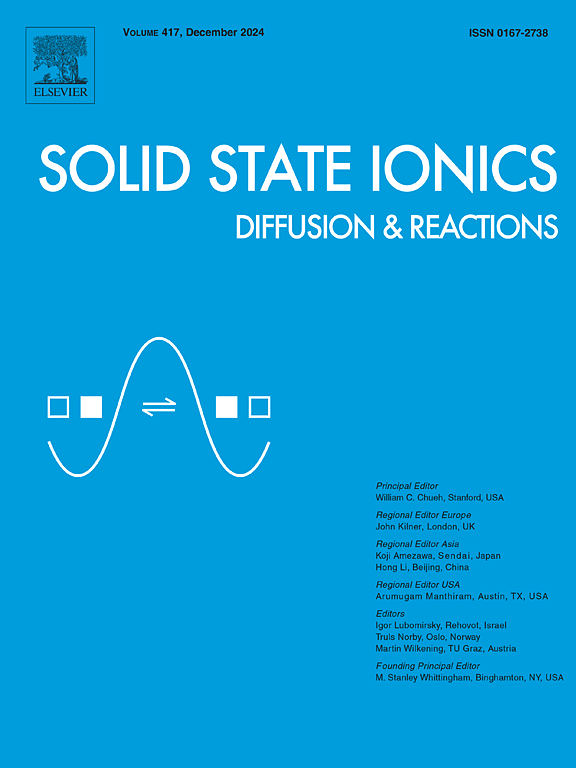固体电解质中锂在边缘位错周围的电化学电位和熵的变化
IF 3.3
4区 材料科学
Q3 CHEMISTRY, PHYSICAL
引用次数: 0
摘要
导出了固体电解质中锂原子在边缘位错附近的电化学电位和熵的方程。尽管在多晶材料中存在许多位错时应力场变得复杂,但至少在位错密度低于1016 m−2时,方程仍然有效,定性结论是稳健的。由于Li+离子的高迁移率,Li+离子在应力场中处于平衡状态时的电化学势在空间上是均匀的,得到了与应力场和电势场相关的熵在空间上的变化。由带正电的位错引起的局域熵的增加,导出了Li+间隙和空位的Frenkel对的浓度,在位错附近可能会相当高。这可能是沿位错方向离子电导率较高的原因。本文认为,在不含杂质的正离子导体中,位错应带正电荷。当由Li+间隙引起的膨胀相对较大时,固体电解质可能在位错附近发生还原或氧化,尽管这需要相当大的原子和电子扩散。本文章由计算机程序翻译,如有差异,请以英文原文为准。
Change of electrochemical potential and entropy of Li around an edge dislocation in solid electrolytes
The equations of the electrochemical potential and entropy of Li atoms near an edge dislocation inside solid electrolytes are derived. Although a stress field becomes complex in the presence of many dislocations in polycrystalline materials, the equations are still valid and the qualitative conclusions are robust at least for lower dislocation density than about . As the modified electrochemical potential of ions in a stress field is spatially uniform at equilibrium in solid electrolytes due to the high mobility of ions, the spatial variations of the entropies associated with the stress and electric-potential field are obtained. From the increase in the local entropy by a positively charged dislocation, the concentration of Frenkel pairs of interstitials and vacancies is derived, which could be considerably higher near the dislocation. It could be the reason for higher ionic conductivity along a dislocation. It is suggested that a dislocation should be positively charged in an ionic conductor of positive ions in the absence of impurities. When the dilation due to interstitials is relatively large, reduction or oxidation of the solid electrolyte may possibly occur near a dislocation although considerable diffusion of atoms and electrons is necessary for it.
求助全文
通过发布文献求助,成功后即可免费获取论文全文。
去求助
来源期刊

Solid State Ionics
物理-物理:凝聚态物理
CiteScore
6.10
自引率
3.10%
发文量
152
审稿时长
58 days
期刊介绍:
This interdisciplinary journal is devoted to the physics, chemistry and materials science of diffusion, mass transport, and reactivity of solids. The major part of each issue is devoted to articles on:
(i) physics and chemistry of defects in solids;
(ii) reactions in and on solids, e.g. intercalation, corrosion, oxidation, sintering;
(iii) ion transport measurements, mechanisms and theory;
(iv) solid state electrochemistry;
(v) ionically-electronically mixed conducting solids.
Related technological applications are also included, provided their characteristics are interpreted in terms of the basic solid state properties.
Review papers and relevant symposium proceedings are welcome.
 求助内容:
求助内容: 应助结果提醒方式:
应助结果提醒方式:


